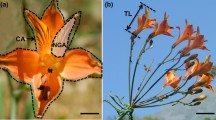Abstract
The evolution and ecology of interactions between plants and pollinators are discussed based on the studies on the Izu Islands and mainland Honshu, Japan. The species assemblage is depauperate, and long-tongued pollinators are absent or rare on the islands. Bumblebees, one of the most important pollinators in Japan, are generally absent. Plants depending strongly on bumblebee pollination are absent on Izu Islands, but those depending on varied pollinators including bumblebees display smaller flower sizes and accommodate smaller pollinators than their mainland counterparts. Breeding systems of these species also shift to partial inbreeding, possibly an evolutionary result of the decrease in pollinator availability. Changes in flowering phenology between mainland and island populations also occur. Plants in the islands tend to reproduce vegetatively less frequently and produce greater numbers of smaller seeds than those in the mainland. The possibility of evolution on the side of island pollinator species is also discussed, although there are few data on this topic.
Similar content being viewed by others
References
Abrahamson W G 1989Plant-animal interactions (New York: McGraw-Hill)
Baker H G 1955 Self-compatibility and establishment after “long-distance” dispersal;Evolution 9 347–348
Barth F G 1985Insects and flowers (Princeton: Princeton Univ. Press)
Carlquist S 1974Island biology (New York: Columbia Univ. Press)
Cox P A 1989 Baker’s law: plant breeding systems and island colonization; inThe evolutionary ecology of plants (eds) J H Bock and Y B Linhart (Boudler: Westview Press) pp 209–224
Faegri K and van der Pijl L 1979The principles of pollination ecology (Oxford: Pergamon Press)
Feinsinger P 1983 Coevolution and pollination; inCoevolution (eds) D J Futuyma and M Slatkin (Sinauer: Sunderland) pp 282–310
Feinsinger P and Swarm L A 1982 “Ecological release,” seasonal variation in food supply, and the hummingbirdAmazilia tobaci on Trinidad and Tobago;Ecology 63 1574–1587
Feinsinger P, Wolf J A and Swarm L A 1982 Island ecology: reduced hummingbird diversity and the pollination biology of plants, Trinidad and Tobago, West Indies;Ecology 63 494–506
Gilbert L E and Raven P H 1975Coevolution of animals and plants (Austin: Univ. of Texas Press)
Heinrich B 1979Bumblebee economics (Cambridge: Harvard Univ. Press)
Inoue K 1988 Pattern of breeding-system change in the Izu Islands inCampanula punctata: bumblebee-absence hypothesis;Plant Sp. Biol. 3 125–128
Inoue K and Amano M 1986 Evolution ofCampanula punctata Lam. in the Izu Islands: change of pollinators and evolution of breeding systems;Plant Sp. Biol. 1 89–97
Inoue K and Kawahara T 1990 Allozyme differentiation and genetic structure in island and mainland Japanese populations ofCampanula punctata;Am. J. Bot. 77 1440–1448
Iwasa Y and Cohen D 1989 Optimal growth schedule of a perennial plant;Am. Nat. 133 480–505
Jain S K 1976 The evolution of inbreeding in plants;Annu. Rev. Ecol. Syst. 7 469–495
Karig D E 1975 Basin genesis in the Philippine Sea; inInitial reports of the deep sea drilling project (eds) D E Karig and J C Ingle (Washington DC: United States Government Printing Office) vol. 31, pp 857–879
Kozlowski J 1992 Optimal allocation of resources to growth and reproduction: implications for age and size at maturity;TREE 7 15–19
Lande R and Schemske D W 1985 The evolution of self-fertilization and inbreeding depression in plants. I. Genetic models;Evolution 39 24–40
Linhart Y and Feinsinger P 1980 Plant-hummingbird interactions: effects of island size and degree of specialization on pollination;J. Ecol. 68 745–760
MacArthur R H 1972Geographical ecology (New York: Harper and Row)
MacArthur R H and Wilson E O 1967The theory of island biogeography (Princeton: Princeton Univ. Press)
Roubik D W, Holbrook N M and Parra V G 1985 Roles of nectar robbers in reproduction of the tropical treeletQuassia amara (Simaroubaceae);Oecologia 66 161–167
Schemske D W 1983 Limits to specialization and coevolution in plant-animal mutualisms; inCoevolution (ed.) M H Nitecki (Chicago: Univ. of Chicago Press) pp 67–109
Schemske D W and Lande R 1985 The evolution of self-fertilization and inbreeding depresion in plants. II. Empirical observations;Evolution 39 41–52
Williamson M 1981Island populations (Oxford: Oxford Univ. Press)
Wyatt R 1983 Pollinator-plant interactions and the evolution of breeding systems; inPollination biology (ed.) L Real (Orlando: Academic Press) pp 51–95
Yahara T 1988 Bumblebees and flowering phenology (in Japanese); inNewton Special Issue (Tokyo: Kyoikusha) vol. 4, pp 16–17
Yumoto T 1986 The ecological pollination syndromes of insect-pollinated plants in an Alpine meadow;Ecol. Res. 185–95
Yumoto T 1987 Pollination systems in a warm temperate evergreen broad-leaved forest on Yaku Island;Ecol. Res. 2 133–145
Yumoto T 1988 Pollination systems in the cool temperate mixed coniferous and broad-leaved forest zone of Yakushima Island;Ecol. Res. 3 117–129
Author information
Authors and Affiliations
Rights and permissions
About this article
Cite this article
Inoue, K. Evolution of mutualism in plant-pollinator interactions on islands. J. Biosci. 18, 525–536 (1993). https://doi.org/10.1007/BF02703084
Received:
Revised:
Published:
Issue Date:
DOI: https://doi.org/10.1007/BF02703084




